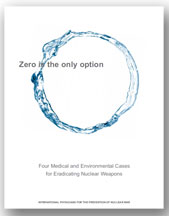How a Regional Nuclear War Will Cause Global Mass Starvation
 Climate scientists who worked with the late Carl Sagan in the 1980s to document the threat of nuclear winter have produced disturbing new research about the climate effects of low-yield, regional nuclear war.
Climate scientists who worked with the late Carl Sagan in the 1980s to document the threat of nuclear winter have produced disturbing new research about the climate effects of low-yield, regional nuclear war.
Using South Asia as an example, these experts have found that even a limited regional nuclear war on the order of 100 Hiroshima-sized nuclear weapons would result in tens of millions of immediate deaths and unprecedented global climate disruption. Smoke from urban firestorms caused by multiple nuclear explosions would rise into the upper troposphere and, due to atmospheric heating, would subsequently be boosted deep into the stratosphere.
The resulting soot cloud would block 7–10% of warming sunlight from reaching the Earth’s surface, leading to significant cooling and reductions in precipitation lasting for more than a decade. Within 10 days following the explosions, there would be a drop in average surface temperature of 1.25° C. Over the following year, a 10% decline in average global rainfall and a large reduction in the Asian summer monsoon would have a significant impact on agricultural production. These effects would persist over many years. The growing season would be shortened by 10 to 20 days in many of the most important grain producing areas in the world, which might completely eliminate crops that had insufficient time to reach maturity.
 There are currently more than 800 million people in the world who are chronically malnourished. Several hundred million more live in countries that depend on imported grain. Even a modest, sudden decline in agricultural production could trigger significant increases in the prices for basic foods, as well as hoarding on a global scale, making food inaccessible to poor people in much of the world. While it is not possible to estimate the precise extent of the global famine that would follow a regional nuclear war, it seems reasonable to anticipate a total global death toll in the range of one billion from starvation alone. Famine on this scale would also lead to major epidemics of infectious diseases, and would create immense potential for mass population movement, civil conflict, and war.
There are currently more than 800 million people in the world who are chronically malnourished. Several hundred million more live in countries that depend on imported grain. Even a modest, sudden decline in agricultural production could trigger significant increases in the prices for basic foods, as well as hoarding on a global scale, making food inaccessible to poor people in much of the world. While it is not possible to estimate the precise extent of the global famine that would follow a regional nuclear war, it seems reasonable to anticipate a total global death toll in the range of one billion from starvation alone. Famine on this scale would also lead to major epidemics of infectious diseases, and would create immense potential for mass population movement, civil conflict, and war.
These findings have significant implications for nuclear weapons policy. They are powerful evidence in the case against the proliferation of nuclear weapons and against the modernization of arsenals in the existing nuclear weapon states. Even more important, they argue for a fundamental reassessment of the role of nuclear weapons in the world. If even a relatively small nuclear war, by Cold War standards—within the capacity of eight nuclear-armed states—could trigger a global catastrophe, then the only viable response is the complete abolition of nuclear weapons.
Two other issues need to be considered as well. First, there is a very high likelihood that famine on this scale would lead to major epidemics of infectious diseases. Previous famines have been accompanied by major outbreaks of plague, typhus, malaria, dysentery, and cholera. Despite the advances in medical technology of the last half century, a global famine on the anticipated scale would provide the ideal breeding ground for epidemics involving any or all of these illness, especially in the vast megacities of the developing world.
Famine on this scale would also provoke war and civil conflict, including food riots. Competition for limited food resources might well exacerbate ethnic and regional animosities. Armed conflict among nations would escalate as states dependent on imports adopted whatever means were at their disposal to maintain access to food supplies.
Resources
- Zero is the only option [complete IPPNW briefing paper]
- Climate and Health Effects of Regional Nuclear War: How sudden global cooling could produce a “nuclear famine” [IPPNW Powerpoint presentation]
- An assessment of the extent of projected global famine resulting from limited, regional nuclear war, by Ira Helfand, MD
- Climatic Consequences of Nuclear Conflict [Web archive by Alan Robock, Department of Environmental Sciences, Rutgers University]


